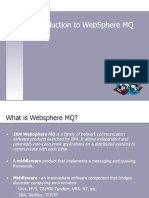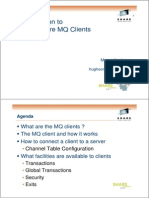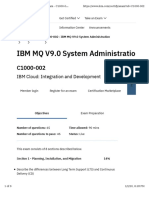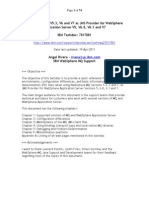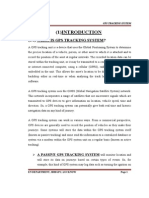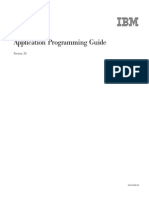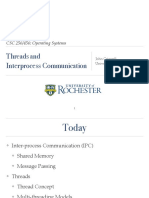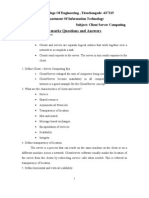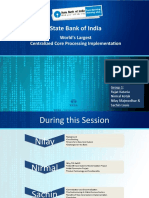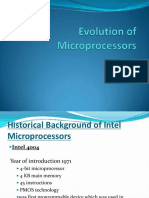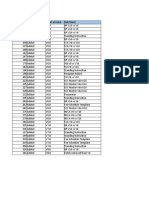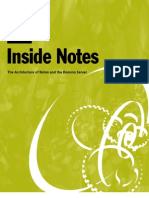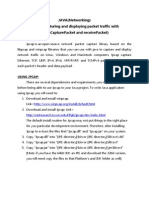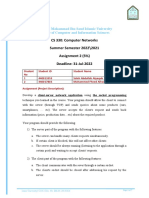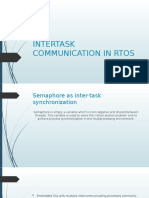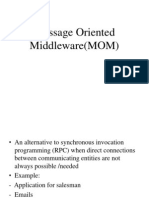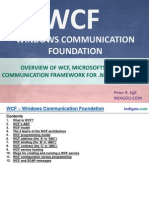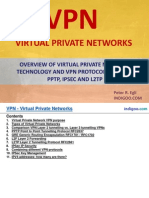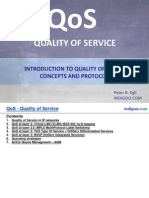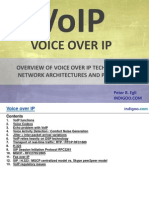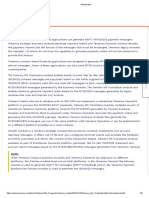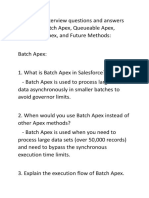MOM Message Oriented Middleware
MOM
indigoo.com
MESSAGE ORIENTED
MIDDLEWARE
OVERVIEW OF MESSAGE ORIENTED MIDDLEWARE
TECHNOLOGIES AND CONCEPTS
Peter R. Egli 2015
Peter R. Egli
INDIGOO.COM
1/25
Rev. 2.20
�MOM Message Oriented Middleware
indigoo.com
Contents
1.
2.
3.
4.
5.
6.
7.
8.
Synchronous versus asynchronous interaction
Messaging models
Queue types
Message broker - application integration pattern
Features of message queue systems
Examples of MOM middleware
Comparison of JMS, MSMQ and AMQP middleware
Comparison of MOM with Internet messaging
Peter R. Egli 2015
2/25
Rev. 2.20
�MOM Message Oriented Middleware
indigoo.com
1. Synchronous versus asynchronous interaction (1/2)
Distributed Object Technologies (DOT), RPC:
Synchronous operation (caller is blocked until callee returns).
Simple remote call:
Client
Remote call with callback:
Server
Client
1: Remote call
Client is
blocked
3: Return
Server
1: Remote call
2. Server
processes
request
3: Callback
Client is
blocked
2. Server
processes
request
4: Callback return
5: Return remote call
Problems / drawbacks with this model of operation:
The client is blocked until the server (object operation) call returns (tight coupling).
Connection overhead (each call needs marshalling, entails protocol overhead for network
access etc.).
Difficult to react to failures (server may throw an exception, may not be active etc.).
Not well-suited for nested calls (server object calls back client object which potentially calls
another server object operation).
Peter R. Egli 2015
3/25
Rev. 2.20
�MOM Message Oriented Middleware
indigoo.com
1. Synchronous versus asynchronous interaction (2/2)
Message Oriented Middleware (MOM):
Asynchronous operation (caller sends a message and continue its work, fire and forget).
Store and Forward communication.
Sender & receiver are loosely coupled:
a. They do not need to be active at the same time.
b. The sender does not need to know the receiver location and vice versa.
Sending system
Sending
application
Receiving system
Non-blocking
message
send operation
Send queue
Receive queue
Analogy:
Synchronous (RPC/DOT)
Telephone
Asynchronous (MOM)
Mail
Peter R. Egli 2015
Receiving
application
Network
4/25
Rev. 2.20
�MOM Message Oriented Middleware
indigoo.com
2. Messaging models
1. P2P - Point to Point:
1 queue per receiver (application).
One-to-one (1 sender, 1 receiver) or many-to-one messaging (many senders, 1 receiver).
Sending
application
Receiving
application
Sending
application
2. Publish Subscribe (PubSub):
One-to-many or many-to-many distribution of messages (same message may be received by
multiple receivers if these are subscribed).
Similar to a message board.
Subscribe
Sending
application
1
Sending
application
Receive
message
Publish
message
2
Publish
message
Message
board
Receiving
application
Receive
message
Receiving
application
Subscribe
Peter R. Egli 2015
5/25
Rev. 2.20
�MOM Message Oriented Middleware
indigoo.com
3. Queue types (1/2)
FIFO queues (first in, first out):
All messages have the same priority level.
Messages are delivered in the order they are sent.
Sending
application
Receiving
application
Priority queues:
Messages are buffered in FIFO queues and ordered based on priority.
N.B.: The ordering applies to the set of messages that are in the queue at a specific
point in time (= messages that are not yet received by an application).
Sending
application
3
Prio 1
Peter R. Egli 2015
2
Prio 3
1
Prio 2
2
Messages
Prio 3
are re-ordered
based on their
priority
1
Prio 2
Receiving
application
Prio 1
6/25
Rev. 2.20
�MOM Message Oriented Middleware
indigoo.com
3. Queue types (2/2)
Public / private queues:
Defines different access rights:
1. Public queue:
All senders may send messages without access control.
2. Private queue:
Sending to a private queue requires sender authentication.
Journal queue:
The message queueing system keeps a copy of every received message for logging or
monitoring purposes.
Dead-letter queue:
Queue that holds undeliverable messages (messages that time out due to time-to-live (TTL)
expiry or whose queue address could not be resolved).
Bridge / connector queue:
Connects different queue systems, e.g. Microsoft Message Queue (MSMQ) and Java Messaging
System (JMS) based messaging systems.
Peter R. Egli 2015
7/25
Rev. 2.20
�MOM Message Oriented Middleware
indigoo.com
4. Message broker - application integration pattern (1/4)
Message brokers distribute messages to receivers.
Case 1: No message broker:
Requires n*(n-1)/2 connections between message queues. Every (endpoint) queue needs
to know all other queues to send message to these queues.
The sender must know the location (address) of the receiver.
This model becomes complex for large numbers of queues (it does not scale).
Application
Application
Bidirectional connections:
6 systems 6 * 5 / 2 = 15 connections
Application
Application
If every application needs to send
messages to all other applications,
6 * 5 = 30 connections are required.
Application
Peter R. Egli 2015
Application
8/25
Rev. 2.20
�MOM Message Oriented Middleware
indigoo.com
4. Message broker - application integration pattern (2/4)
Case 2: Message broker:
The message broker serves as a central exchange of messages (hub and spoke architecture,
broker routes messages to the destination queue).
A message broker provides additional decoupling between senders and receivers.
The broker may perform additional functions such as filtering, message transformations
(e.g. enrich messages with data from a DB) and load balancing.
Application
Application
Message broker = central message exchange
Application
Application
Application
Peter R. Egli 2015
Application
9/25
Rev. 2.20
�MOM Message Oriented Middleware
indigoo.com
4. Message broker - application integration pattern (3/4)
Case 3: Multi-hub message broker system:
Generalization of message hub architecture (hierarchy of message hubs).
Application
Application
Application
Application
Application
Application
Application
Peter R. Egli 2015
Application
10/25
Rev. 2.20
�MOM Message Oriented Middleware
indigoo.com
4. Message broker - application integration pattern (4/4)
Case 4: Federated message brokers:
Generalization of the multi-hub message broker pattern.
Applications are bound to a specific message broker (home message broker).
Message brokers are under the responsibility of different organizations (federation).
Case 5: PubSub broker:
Rather than distributing messages to queues, the message broker routes messages to
subscribers.
Thus messages may be sent to multiple receivers (multicast).
In JMS a PubSub broker is a called "topic".
Sending
application
Publish
message
Receive
message
Receiving
application
Broker
Sending
application
Peter R. Egli 2015
2
Publish
message
Receive
message
Receiving
application
11/25
Rev. 2.20
�MOM Message Oriented Middleware
indigoo.com
5. Features of message queue systems (1/4)
Asynchronous operation:
Sending of messages is unblocking. The sender application may continue its work, the sender
queue tries to deliver the message on behalf of the sender application (until successful).
Transaction support:
Sending and receiving a series of messages may be packed into a transaction. Either all
messages are successfully sent and received or none.
In-order delivery:
Messages are queued in the order they are sent. However, messages may overtake messages
other based on priorities.
Priority-based delivery:
Messages are queued according to a priority scheme (the receiver queue passes messages
with highest priority first to the receiving application).
Peter R. Egli 2015
12/25
Rev. 2.20
�MOM Message Oriented Middleware
indigoo.com
5. Features of message queue systems (2/4)
Message formatting:
Possibility to wrap the messages into formats such as SOAP (messages are wrapped in
SOAP over HTTP protocols for better Internet traversal), XML or plain text.
Notification services (triggers):
Receiver:
The queue sends notifications of new enqueued messages to the receiver.
Sender:
The queue sends notifications of the successful delivery of sent messages
to the sender.
Message filtering:
The queue performs filtering based on different criteria:
Message properties (message header fields), e.g. priority.
Message body (e.g. SQL expression).
Message routing:
Message forwarding through intermediate message queues (= brokers).
Message routing may be based on different criteria (e.g. current workload on destination
queues for load balancing).
Peter R. Egli 2015
13/25
Rev. 2.20
�MOM Message Oriented Middleware
indigoo.com
5. Features of message queue systems (3/4)
Message security:
Apply security functions like message authentication, encryption and message integrity.
Supported message transport protocols:
Messages may be transported over a range of different transport protocols.
Typical transport protocols used for message transport are:
TCP or UDP (simplest transport protocol)
HTTP or HTTPs (good for sending messages over the Internet)
SMTP
FTP
Messaging system proprietary transport protocol
Message peek and receive:
Peeking allows a receiving application to receive a copy of a message from a queue.
The message is left in queue.
Only a receive operation actually removes the message from the queue ("pop" a message).
Peter R. Egli 2015
14/25
Rev. 2.20
�MOM Message Oriented Middleware
indigoo.com
5. Features of message queue systems (4/4)
Delivery mode, Quality of Service (QoS):
Exactly-once (guaranteed delivery, highest QoS):
Persistent mode, messages survive queue crashes.
The sending queue keeps the message in persistent store until it receives a positive
acknowledge of the correct reception of the message by the target application.
At-least-once (guaranteed delivery):
Guaranteed delivery, but duplicates of messages may be sent to the application.
The sending queue keeps the message in persistent store (like exactly-once).
After a crash, the sending queue does not query the receiving queue if it already has
received the message, but just re-sends the message.
If the sending queue crashed just prior to receiving the positive acknowledge from the
receiving queue, the message is delivered twice.
At-most-once (no delivery guarantee, lowest QoS):
Non-persistent mode.
Crash
Sending
application
Persistent
queue
Peter R. Egli 2015
Receiving
application
Network
(TCP/IP)
Persistent
queue
15/25
Rev. 2.20
�MOM Message Oriented Middleware
indigoo.com
6. Examples of MOM middleware (1/7)
IBM WebSphere MQ (1/3):
Multiplatform MOM from IBM. Available on IBM platforms, .Net, Linux etc.
Various APIs such as JMS, XMS (JMS API for .Net, C/C++), MQI (MQ native interface).
Main elements of WebSphere MQ:
Queue manager:
Container for a message queue.
The QM is responsible for transferring messages to
other queue managers over a message channel.
The queue manager may reside on the same host
as the application or on a separate host.
Host A
Application A
Application B
Host B
(queue manager for appl. B
is located on another host)
Client channel between
application and QM
Host C
Queue Manager B
Queue Manager A
Host D
Network
Message
Channel Agent
Peter R. Egli 2015
Message channel
Message
Channel Agent
QM D
Message channel
16/25
Rev. 2.20
�MOM Message Oriented Middleware
indigoo.com
6. Examples of MOM middleware (2/7)
IBM WebSphere MQ (2/3):
The main supported topologies are:
1. Hub and spoke topology (point-to-point queues):
Applications subscribe to "their" queue manager.
Routes to hub QM are manually defined in spoke QMs.
Client
appl.
Client
appl.
Spoke
QM
Client
appl.
Hub
QM
Spoke
QM
Client
appl.
Server
appl.
Spoke
QM
Client
appl.
Peter R. Egli 2015
Spoke
QM
Spoke
QM
17/25
Rev. 2.20
�MOM Message Oriented Middleware
indigoo.com
6. Examples of MOM middleware (3/7)
IBM WebSphere MQ (3/3):
2. Distributed PubSub:
Applications subscribe to topics and send messages to multiple receivers (publish).
2 Topologies: Clusters and trees.
2.1. Cluster:
Cluster of queue manager connected by channels between QMs.
Published messages are sent to all connected queue managers of the published topic.
PubSub cluster topology (source: www.redbooks.ibm.com
WebSphere MQ V7.0 Features and Enhancements)
2.2 Tree:
Trees allow reducing the number of channels between the QMs.
PubSub tree topology (source: www.redbooks.ibm.com
WebSphere MQ V7.0 Features and Enhancements)
Peter R. Egli 2015
18/25
Rev. 2.20
�MOM Message Oriented Middleware
indigoo.com
6. Examples of MOM middleware (4/7)
Sonic Software SonicMQ:
P2P and PubSub messaging.
Exactly-once delivery semantics.
Support for message broker clusters with load balancing.
Various messaging bridges to other queueing systems (JMS, IBM WebSphere MQ, Tibco
Rendezvous, FTP, Email).
Microsoft MSMQ:
Guaranteed message delivery (message delivered even when queue is temporarily down).
Message routing.
Security (optional authentication and encryption).
Priority-based messaging.
Different message transport protocols.
Bridge to IBM MQSeries messaging system available.
Peter R. Egli 2015
19/25
Rev. 2.20
�MOM Message Oriented Middleware
indigoo.com
6. Examples of MOM middleware (5/7)
AMQP Advanced Message Queueing Protocol
Why AMQP?
1. Lack of standardization:
There is little standardization in MOM products (mostly proprietary solutions).
For example, JMS is dependent on Java and does not specify a wire protocol but only an API.
Therefore different JMS providers are not directly interoperable on the wire level.
2. Need for bridges for interoperability:
To achieve interoperability between the different queueing systems, 3rd party vendors offer
bridges.
These bridges complicate the architecture / topology, increase costs and reduce performance
(additional delay).
Peter R. Egli 2015
20/25
Rev. 2.20
�MOM Message Oriented Middleware
indigoo.com
6. Examples of MOM middleware (6/7)
AMQP characteristics:
Open protocol for business messaging, with support of industry (Cisco, Microsoft, Red Hat,
Deutsche Bank, Microsoft etc.).
Multi-platform / language messaging system.
AMQP defines:
a. Messaging capabilities (called AMQP model)
b. Wire-level protocol for interoperability
AMQP messaging patterns:
a. Request-response (messages delivered to a specific queue)
b. PubSub (messages delivered to a set of receiver queues)
c. Round-robin (distribution of messages to a set of receiver based on availability)
Main components of AMQP model:
Applications send
(publish) messages
to exchanges
User
Message exchange:
Exchanges receive
messages and dispatch
these to queues.
Peter R. Egli 2015
Binding:
Defines the routing
of messages
to a message queue.
Message queue
21/25
Rev. 2.20
�MOM Message Oriented Middleware
indigoo.com
6. Examples of MOM middleware (7/7)
MQTT Message Queueing for Telemetry Transport:
Most MQ systems and protocols are aimed at backend and enterprise applications.
As such, these technologies are not suited for constrained devices like sensor nodes.
Such devices are typically contstrained in terms of memory, bandwidth and power.
MQTT is a message oriented protocol aimed at applications like wireless sensor networks, M2M
(Mobile 2 Mobile) and ultimately Internet of Things (large number of nodes and applications
loosely coupled through a messaging system).
TCP/IP based
network (wired, wireless)
App
App
Sensor
Node
Peter R. Egli 2015
App
MQTT
Broker
Application
App
Actor
Node
22/25
Rev. 2.20
�MOM Message Oriented Middleware
indigoo.com
7. Comparison of JMS, MSMQ and AMQP middleware (1/2)
Service
JMS
MSMQ
AMQP
Dead-letter queue
Yes
Yes
Yes
Journal queue
~ Persistent delivery mode
Yes (global and for each queue)
~ Persistent messages
Multicast / distribution list
Topics
Multicast, distribution lists, multiple
receiver format names
* Topics (pubsub)
* Fanout (send to all bound rx queues)
Message delivery QoS
* Persistent delivery mode
* Different message ack
types
* Message priorities
Guaranteed message delivery:
* MSMQ transactions
* Recoverable message type
* Different message ack types
Yes (exactly-once delivery semantics
of a session):
* Persistent / non-persistent delivery
modes
* Message priorities
* Only message ack and no-ack
modes defined
Message routing
More complicated routing
schemes based on
hierarchic topics and client
message selection filters
Yes (requires AD / Windows domain)
Complex routing schemes possible
based on routing key (contains
destination matching criteria)
Security
JMS specification itself
does not provide security
(left to the JMS provider)
Yes (optional authentication and
encryption)
Yes (SASL)
Peek queue (check if message
available without receiving)
Yes (QueueBrowser object)
Yes
No
Priority based messaging
Yes (10 priority levels)
Yes (8 priority levels)
Yes (10 priority levels)
AD:
Active Directory
QoS: Quality of Service (features for guaranteeing delivery)
SASL: Simple Authentication and Security Layer (RFC4422)
Peter R. Egli 2015
23/25
Rev. 2.20
�MOM Message Oriented Middleware
indigoo.com
7. Comparison of JMS, MSMQ and AMQP middleware (2/2)
Service
JMS
MSMQ
AMQP
Message transport protocol
JMS does not define a
specific transport (wire)
protocol (left to JMS
providers)
TCP, HTTP, HTTPs, native OS, SPX
TCP & SCTP (UDP transport may be
added in future versions of AMQP)
Message transactions
Yes
Yes
Yes
Receive triggers
No client triggering (left to
JMS provider
implementation)
Yes
Not part of the specification (AMQP
provider may add this functionality)
Message formatting
None defined (JMS does not
define a wire protocol)
XML, binary, ActiveX format
1 binary wire protocol defined in the
specification
Acknowledgment types
3 acknowledgment types /
modes defined
Yes (8 different ack types)
2 modes (message acknowledgment
and no message acknowledgement)
SCTP: Stream Control Transmission Protocol (RFC4960), connection-oriented transport protocol with better characteristics than TCP
SPX:
Sequenced Package Exchange (legacy Novell transport protocol)
Peter R. Egli 2015
24/25
Rev. 2.20
�MOM Message Oriented Middleware
indigoo.com
8. Comparison of MOM with Internet messaging
Message queue systems share many properties and characteristics with Email systems.
For many of the message queue concepts there is a corresponding concept in Email systems.
MOM / Messaging
Email
MOM message
SMTP message
Message queue
Mailbox
Consumer
POP3 / IMAP4 client
Producer
SMTP client
Queue manager
MTA (Mail Transfer Agent)
Routing key
To: / Cc: address
Publish / subscribe
Mailing list
Message filter
E.g. server-side spam check
Message acknowledge
Read receipt (MS Outlook), email tracking (embedded links)
Transactional messaging
Not available
TTL
Expires header field
Communication between applications or components
Communication between users
Peter R. Egli 2015
25/25
Rev. 2.20

